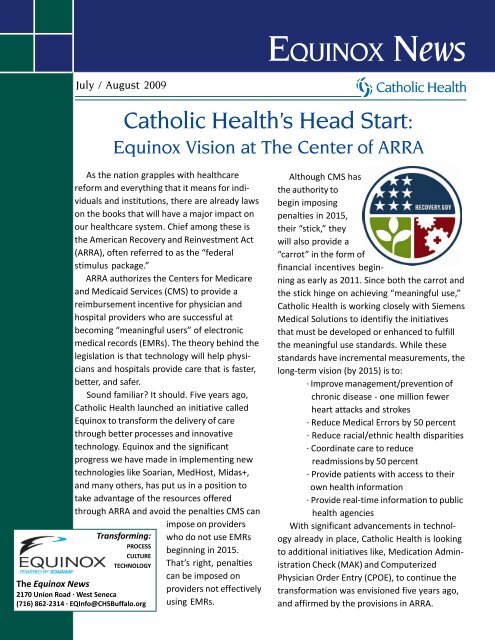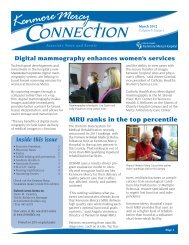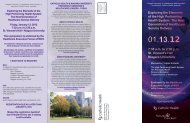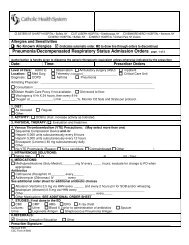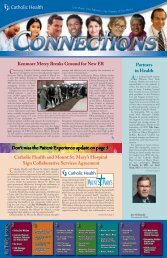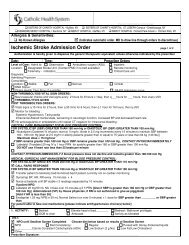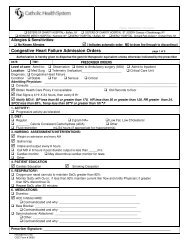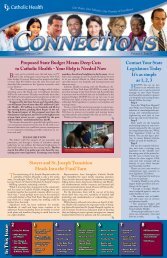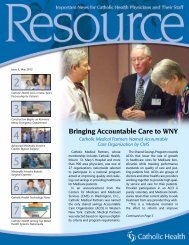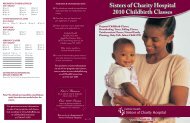EQ News Jul-Aug09 Draft.p65 - Catholic Health System
EQ News Jul-Aug09 Draft.p65 - Catholic Health System
EQ News Jul-Aug09 Draft.p65 - Catholic Health System
Create successful ePaper yourself
Turn your PDF publications into a flip-book with our unique Google optimized e-Paper software.
<strong>EQ</strong>UINOX <strong>News</strong><br />
<strong>Jul</strong>y / August 2009<br />
<strong>Catholic</strong> <strong>Health</strong>’s Head Start:<br />
Equinox Vision at The Center of ARRA<br />
As the nation grapples with healthcare<br />
reform and everything that it means for individuals<br />
and institutions, there are already laws<br />
on the books that will have a major impact on<br />
our healthcare system. Chief among these is<br />
the American Recovery and Reinvestment Act<br />
(ARRA), often referred to as the “federal<br />
stimulus package.”<br />
ARRA authorizes the Centers for Medicare<br />
and Medicaid Services (CMS) to provide a<br />
reimbursement incentive for physician and<br />
hospital providers who are successful at<br />
becoming “meaningful users” of electronic<br />
medical records (EMRs). The theory behind the<br />
legislation is that technology will help physicians<br />
and hospitals provide care that is faster,<br />
better, and safer.<br />
Sound familiar? It should. Five years ago,<br />
<strong>Catholic</strong> <strong>Health</strong> launched an initiative called<br />
Equinox to transform the delivery of care<br />
through better processes and innovative<br />
technology. Equinox and the significant<br />
progress we have made in implementing new<br />
technologies like Soarian, MedHost, Midas+,<br />
and many others, has put us in a position to<br />
take advantage of the resources offered<br />
through ARRA and avoid the penalties CMS can<br />
Transforming:<br />
PROCESS<br />
CULTURE<br />
TECHNOLOGY<br />
The Equinox <strong>News</strong><br />
2170 Union Road · West Seneca<br />
(716) 862-2314 · <strong>EQ</strong>Info@CHSBuffalo.org<br />
impose on providers<br />
who do not use EMRs<br />
beginning in 2015.<br />
That’s right, penalties<br />
can be imposed on<br />
providers not effectively<br />
using EMRs.<br />
Although CMS has<br />
the authority to<br />
begin imposing<br />
penalties in 2015,<br />
their “stick,” they<br />
will also provide a<br />
“carrot” in the form of<br />
financial incentives beginning<br />
as early as 2011. Since both the carrot and<br />
the stick hinge on achieving “meaningful use,”<br />
<strong>Catholic</strong> <strong>Health</strong> is working closely with Siemens<br />
Medical Solutions to identifiy the initiatives<br />
that must be developed or enhanced to fulfill<br />
the meaningful use standards. While these<br />
standards have incremental measurements, the<br />
long-term vision (by 2015) is to:<br />
· Improve management/prevention of<br />
chronic disease - one million fewer<br />
heart attacks and strokes<br />
· Reduce Medical Errors by 50 percent<br />
· Reduce racial/ethnic health disparities<br />
· Coordinate care to reduce<br />
readmissions by 50 percent<br />
· Provide patients with access to their<br />
own health information<br />
· Provide real-time information to public<br />
health agencies<br />
With significant advancements in technology<br />
already in place, <strong>Catholic</strong> <strong>Health</strong> is looking<br />
to additional initiatives like, Medication Administration<br />
Check (MAK) and Computerized<br />
Physician Order Entry (CPOE), to continue the<br />
transformation was envisioned five years ago,<br />
and affirmed by the provisions in ARRA.
2 Big MAK<br />
Medication Administration Check<br />
Requires Team Approach<br />
It’s not likely that in 1974, the employees at a<br />
small supermarket in Toledo, OH ever envisioned<br />
that the first UPC scanner they were using would<br />
one day keep patients safe. Thirty-five years later,<br />
however, that’s exactly where we are.<br />
UPC codes and the scanners that read them,<br />
commonly referred to as bar code technology, are<br />
playing an important role in improving patient<br />
safety at <strong>Catholic</strong> <strong>Health</strong>. Although the technology<br />
is well established, applying it to this intricate<br />
process and tying it to Soarian and other systems is<br />
extremely complex. Multiple clinical and nonclinical<br />
departments are involved in every step from<br />
the procurement of medications, through their<br />
packaging, storage, prescribing, dispensing, administering<br />
and documentation.<br />
The MAK initiative, which began last year, will<br />
see its first pilot program begin on October 27 on<br />
two Med/Surg floors of Mercy Hospital of Buffalo.<br />
Getting to this point required the dedicated effort<br />
of a multidisciplinary team that included representatives<br />
from the medical staff, nursing, pharmacy,<br />
respiratory therapy, quality assurance/process<br />
improvement, information technology, purchasing,<br />
finance, human resources, security, and our partners<br />
at Siemens Medical solutions.<br />
This team has been meeting bi-weekly to cover<br />
every step in the process in order to account for<br />
every scenario from regular medication, to IV drugs,<br />
and self-administered medication. They also<br />
needed to study various patient settings where the<br />
type of drugs and manner of administration may be<br />
different. The unique perspectives of each team<br />
member will allow us to build a robust process to<br />
which technology can be applied - this is likely one<br />
of the best examples of the Equinox methodology<br />
(process, culture, technology) to date.<br />
Members of the MAK interdisciplinary team discuss<br />
the documentation of self-administered drugs at a<br />
recent meeting.<br />
In addition to the interdisciplinary committee,<br />
there is an IT/Pharmacy group, an Executive MAK<br />
Committee, and a dedicated Pharmacy Workgroup.<br />
The many processes reviewed and redesigned in<br />
advance of the new MAK technology include the<br />
design of associate name badges, the design and<br />
production of patient wrist bands, the standardization<br />
of medication administration times, and even the<br />
packaging of medication. This has been a huge part<br />
of the Equinox approach and is the difference between<br />
“transformation” and a simple change in<br />
technology.<br />
The MAK initiative holds tremendous promise for<br />
<strong>Catholic</strong> <strong>Health</strong> and the patients we serve. Among<br />
the potential benefits are a reduction of “never<br />
events” to less than two per month and even a more<br />
mundane goal of a reduction in paper usage by ten<br />
percent when medication administration reports<br />
(MARs) are no longer printed.<br />
There are dozens of associates working on this<br />
important project within the framework of the various<br />
established MAK committees. Their work is critical to<br />
our success in improving quality and patient safety.
Taking AIM at CPOE:<br />
New Approach Targets<br />
Faster Implementation<br />
What is CPOE? Computerized physician order<br />
entry (CPOE), is a process of electronic entry of<br />
licensed medical practitioner instructions for the<br />
treatment of patients under his or her care. These<br />
orders are communicated over a computer network<br />
(Soarian) to the medical staff or to the departments<br />
(pharmacy, laboratory, radiology, etc.) responsible for<br />
fulfilling the order. CPOE decreases delay in order<br />
completion, reduces errors related to handwriting or<br />
transcription, allows order entry at point-of-care or<br />
off-site, provides error-checking for duplicate or<br />
incorrect doses or tests, and simplifies inventory and<br />
posting of charges.<br />
Why are we implementing CPOE? In the past,<br />
physicians have traditionally hand-written or verbally<br />
communicated orders for patient care, which are then<br />
transcribed by various individuals such as unit clerks,<br />
nurses, and ancillary staff before being carried out.<br />
According to a 1999 Institute of Medicine (IOM)<br />
report, handwritten reports or notes, non-standard<br />
abbreviations and poor legibility can lead to errors<br />
and risks patient safety. A follow up IOM report in<br />
2001 recommended the use of electronic medication<br />
ordering, with computer- and internet-based information<br />
systems to support clinical decisions. Prescribing<br />
errors are the largest identified source of preventable<br />
hospital medical errors. A 2006 report by the IOM<br />
estimated that a hospitalized patient is exposed to a<br />
medication error each day of his or her stay. Studies<br />
have shown that CPOE reduces the medication error<br />
rate by 80%, and by 55% for errors with serious<br />
potential patient harm.<br />
What does AIM mean? AIM is an acronym that<br />
stands for “Agile Implementation Methodology.” As<br />
part of the many initiatives that make-up Equinox,<br />
CPOE was slated to fall within the strategic plan that<br />
saw the implementation of other clinical applications<br />
3<br />
including Soarian Clinical Access, Soarian Common<br />
Clinicals, and Soarian Clinical Team precede its<br />
development and use. The original timeline for<br />
implementation called for a ten-month project. The<br />
AIM approach, developed by our partners at Siemens,<br />
will cut that time in half to approximately five<br />
months.<br />
The American Recovery and Reinvestment Act<br />
(ARRA) and the incentives associated with it was a<br />
major reason for the move to the “AIM” methodology.<br />
The change in the approach to CPOE implementation<br />
will mean a greater commitment from our partners at<br />
Siemens, who will have more resources on-site.<br />
The groundwork provided by the dozens of physicians<br />
and clinical professionals working on Clinical<br />
Standardization allows us to confidently move forward<br />
with CPOE at a more rapid pace. The pilot group<br />
will include hospitalists and residents and they will<br />
have access to more than 100 convenient order sets<br />
and 20 diagnosis-specific order sets.<br />
There are currently 14 healthcare organizations<br />
across the country using Soarian CPOE. As part of the<br />
AIM methodology, <strong>Catholic</strong> <strong>Health</strong> will be able to<br />
draw-upon best practices from those organizations.<br />
Combined with MAK, CPOE will mark one of the<br />
most significant improvements in patient safety in<br />
the history of <strong>Catholic</strong> <strong>Health</strong> and its individual<br />
ministries.
4<br />
Connecting With Our Community<br />
Imagine for a moment that you are at a bank<br />
applying for a mortgage to purchase<br />
a new home. After filling out<br />
a few forms, the loan officer informs<br />
you that he will need to do a<br />
credit check and verify your income.<br />
This sounds reasonable,<br />
right? But then he tells you that<br />
you will need to visit each of your<br />
creditors to get a copy of your<br />
history and any outstanding balances,<br />
go to any and all banks<br />
where you have accounts to get<br />
copies of your statements, and be<br />
sure to get a letter from your<br />
employer to verify you have a job<br />
and enough income!<br />
Doesn’t sound so reasonable<br />
anymore, does it? After all, what if<br />
you miss something, you might not<br />
get the loan. What if the bank<br />
misses something, they might<br />
put themselves at risk. Isn’t this<br />
why we have computers?<br />
Shockingly, this is exactly the<br />
process we have right now if our<br />
medical information is confined<br />
to a physician’s office or a paper chart. And it’s<br />
a bit more dangerous for your physician, rather<br />
than your loan officer, to miss some important<br />
information. That is why electronic medical<br />
records are so important, and why <strong>Catholic</strong><br />
<strong>Health</strong> has invested not only in our own systems<br />
like Soarian, but also in a community-wide<br />
initiative called HEALTHeLINK.<br />
HEALTHeLINK is the Western New York<br />
Clinical Information Exchange. It is designed to<br />
“link” the WNY healthcare community<br />
together so clinical information<br />
can be exchanged between and<br />
among providers quickly and<br />
efficiently. In a non-emergent<br />
situation it’s convenient for you<br />
and your healthcare providers. In<br />
an emergency, access to your<br />
medical information could save<br />
your life.<br />
<strong>Catholic</strong> <strong>Health</strong> along with all<br />
the other major hospitals, hundreds<br />
of physicians, several labs<br />
and pharmacy systems, and<br />
health insurers have collaborated<br />
to develop the technology to<br />
exchange information quickly and<br />
safely. The rest is up to you.<br />
When you visit a physician who<br />
participates in HEALTHeLINK, you<br />
can choose to have your information<br />
available to those<br />
healthcare professionals across<br />
the region that may need it by<br />
signing a consent form. Your<br />
information is not stored in any<br />
“central database,” rather it is<br />
secure within the organizations<br />
that record it. Consenting to participation<br />
allows for the secure electronic retrieval of that<br />
information by authorized medical professionals.<br />
You can visit WNYHEALTHeLINK.com for<br />
more information or to obtain a consent form.<br />
Questions?<br />
Send an e-mail to:<br />
<strong>EQ</strong>Info@CHSBuffalo.org


